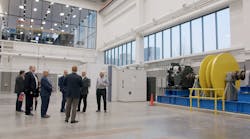TK Elevator's new headquarters emphasizes transparency and technology
Elevators and escalators use as much as 25% of a building’s total energy consumption, so a research facility by TK Elevator (TKE) that aims to improve their efficiency is a step toward a smaller carbon footprint. But the facility, part of the company’s new North American headquarters in Atlanta, might also be seen as a metaphor for an industrial sector moving toward greater product transparency and integration with smart technologies in response to market demand.
Standing out figuratively and literally above the three-building, 210,000-square-foot complex is TKE's 420-foot-tall Innovation and Qualification Center (IQC), which is pursuing LEED Gold certification from the U.S. Green Building Council. Whereas some manufacturers might tuck away their R&D efforts in the suburban outskirts, TKE picked The Battery Atlanta, a bustling mixed-use development that also hosts Truist Park, home of the Atlanta Braves. “We wanted to be something different than the other elevator companies,” said TKE NA CEO and president Kevin Lavallee during the headquarters’ Feb. 9 opening. “We wanted to be bold, we wanted to be unique.”
TKE with global architecture firm Gensler further defied the norm by opening much of the IQC to public view. A glazed curtain wall covers nearly the entirety of the tower’s 85-foot-wide east elevation and parts of its north and south elevations. Granted, passersby won’t be able to see burgeoning R&D prototypes through the glass. “What we’re showing is the inner workings of our elevator systems, our mature product,” says Stephen Allen, TKE vice president of engineering. “[W]e use elevators every day, and people don't have an understanding of how they operate … or of what goes into the system.”
The theme of knowledge sharing further manifests in a ground-level educational showroom of conveying technology that includes about 20 vignettes, including interactive elevator miniatures and a full-scale escalator with a glass curtain, exposing its mechanical underbelly. “We've been working with TKE in the last several years to create content platforms,” says Gensler global brand leader Jerry Alexander. “We can deliver a lot of information to our various audiences, be it developers, STEM students, code officials, or architects.” The showroom also overlooks TKE’s subgrade testing and certification laboratories.
But one need not be on the same block of the IQC to glimpse its activities. Of the structure’s 18 elevator shafts, two are in active operation along the full height of the transparent east elevation. Elevator components—hoist cables, counterweight, and roller guides—typically tucked away are visible through the shaft walls, also glass. Layers of lighting further highlight the building-scale exhibit, including cannons that illuminate the hoistways, LEDs on the cabins, and a can’t-miss 11,000-square-foot LED mesh display that animates the city skyline 230 to 340 feet above grade.
The strategic transparency and embrace of technology extend to TKE’s digitalization of elevator operations, which Allen says was among the first in the sector: “We saw a tremendous opportunity to monitor elevator systems.” Through its Max Digital Services, the company is able “to get data from the elevators during their operations … and to predict mechanical failures or other types of issues before they actually occur [and become] a problem for our customers,” he says. “It's a great way to utilize technology and blend it with brick-and-mortar industrial type equipment.”
The digital mindset enabled the company to act quickly when interest in touchless user interfaces skyrocketed during the COVID-19 pandemic. In February 2021, TKE released its Agile mobile app, with which building tenants can call elevator systems through different digital channels. Once a user’s credentials are verified, Allen says, the mobile app “gives you the access, but it can also be integrated with visitor management systems … and with the building management side.”
For the most part, Allen says data collected through TKE’s digital products can feed into a holistic building management system. “There are certain things within the elevator system that have to stay within the elevator system,” he notes, but TKE is “seeing a lot of activity” in coordinating data from elevator operations with that of other building systems, including security, life safety, and energy management.
On this last point, Allen says sustainability is a driving force in TKE’s push in the smart building landscape. The company, which is targeting carbon neutrality by 2050, has published Environmental Product Declarations as well as Health Product Declarations on several products. It has also sought certification for product components through the Cradle to Cradle Institute and the International Living Future Institute’s Declare initiative.
TKE is also working to ensure its products support the environmental certification prospects of the buildings in which they are installed, Allen adds: “We have high-level certifications on the energy efficiency of our control systems and our elevator systems.”
Through its physical construction, educational mission, and sustainability efforts, the new TKE NA headquarters might lead to a design industry wiser not only on elevator operations, but also on the role of smart buildings in a more environmentally conscious future.
For more news, projects, and profiles in the smart buildings ecosystem, subscribe to the SBT newsletter and follow us on LinkedIn, Twitter, and Facebook.



